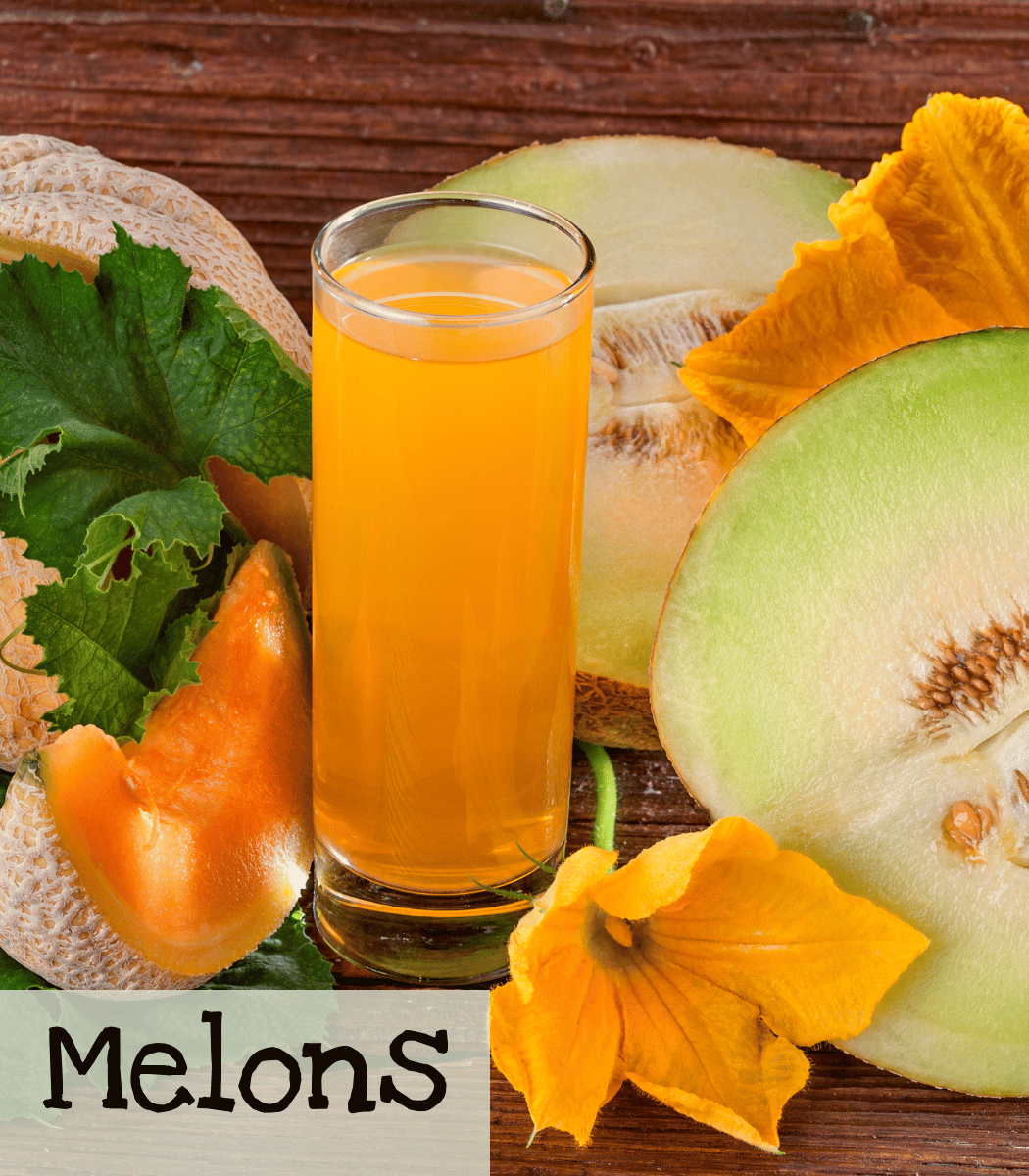
Melon
Thought to have originated in the Middle East and Asia, melons have a wide range of sizes, colors, and sweetness.
|
Bidwell Casaba; Golden Honey; Model; Prescott Fond Blang: Rich Sweetness 132; White Lanzhou; Jenny Lind; Tigger Meti Dark Green Serpent–it’s used like a cucumber |
|
Cucumis melo Cucumbis melo: Metki Dark Green Serpent
|
|
Easy |
|
Difficult |
|
5 years if properly cured, cleaned, and stored |
|
Annual |
|
5-14 Days |
|
Full sun |
|
70-92 days |
|
Bidwell Casaba: 16 LB Prescott Fond Blang: 4-9 LB Model: 2-3 LB Rich Sweetness 132: tennis ball size Tigger: 1 LB
|
|
March, April, May, June |
|
Yes |

Growing Tips

When to Start
Spring: Direct sow after all danger of frost has passed. (May 1 for Jefferson, GA) (Mar 20-Jun 20 for the state of GA)
Transplant: Start seedlings 4 weeks before the last frost date and transplant after all danger of frost has passed. (May 1 for Jefferson, GA)
How to Grow
When planting melons, wait until the threat of frost has passed and the soil has warmed in spring. (May 1 for Jefferson, GA) Direct sowing is best. However, there are reasons to start indoors. One of which is if you have a shorter growing season. (Just keep the plant from becoming root bound.) Another is if you are using the melon as a trap crop. For more information on how to use and maintain trap crops, see Pest Management.
Plant in full sun and well-draining soil. Plant from ½ to 1 inch deep, and in groups of 2-3. Space groups about 2 feet apart with rows 5-6 feet apart. (For the Weeks NC Giant space 2-3 apart.) Harden off any transplants and plant after all danger of frost has passed.
Care
Melons are mostly made up of water. Water 1-2 inches per week, preferably through drip irrigation. Soaker hoses or drip irrigation will keep the leaves dry helping to prevent disease. Melons do hate wet feet, so check the soil moisture before watering. If it’s dry an inch down, it’s time to water. Mulching the plants helps maintain the soil moisture and keep down weeds.
It is best to keep the fruit from direct contact with the soil. You can use mulch, cardboard, or cantaloupe cradles. Melons face a variety of pests which can prove challenging. They are in the same family as cucumbers. And they have the same pest problems as both squashes and cucumbers. See Pest Management for helpful tips.
Harvest
Be careful to not water as the melons start to reach maturity. They will be more flavorful if you do this. Melons should be ready for harvesting about a month after the fruit has set. A ripe melon will separate from easily the stem. If it doesn’t, leave it a little longer but check often.
Pro Tip!
Incompatibles: None
Grows well with: Squashes (both winter and summer), radishes
Seed Saving

Isolation Distance
Separate varies of Cucumis melo by ½ mile or cage and hand-pollinate.
Instructions
Harvest for seeds when the melon is ripe for eating. Store the harvested melon intact for an additional 3 weeks before removing and cleaning the seeds.
Fermenting the seed/pulp mixture for 3 to 4 days before cleaning can help prevent passing disease and fungus from generation to generation, but is not required.
Scoop the seeds—together with the pulp that surrounds them—into a jar or bowl with a little water (about half as much water as seeds and pulp). Remove the seeds that float and pulp. Viable (good) good seeds will sink to the bottom. Pour the viable seeds into a colander.
Rub them underwater between your fingers gently but thoroughly while cleaning them, to remove the naturally occurring gel from their coats. Dry the cleaned seeds on a shiny surface (they will stick to the paper) until they are brittle.
Features
- Bidwell Casaba: It produces massive fruit that weigh about 16 lbs each and are football-shaped. The orange flesh is sweet and creamy.
- Golden Honeymoon: Heirloom. A brilliant, gold rind and delicious green flesh; unique flavor. Two weeks earlier than regular honeydew; excellent yields. It’s unique and rare.
- Jenny Lind: Heirloom. A green melon that is sweet.
- Model: Green flesh with a very sugary flavor. Heirloom. Comes from Poland.
- Prescott Fond Blang: A French melon with gray/green skin that turns a straw color. One of the best-known melons (but not widely known in the US), it has a rich flavor and is very fragrant.
- Rich Sweetness 132: Vines can be trained up a trellis. Produces a large yield of sweet, fragrant fruit early in the season. Heirloom, originally from the old Soviet Union.
- White Lanzhou: Originally from China, it was introduced to the US in the 1940s. Honeydew-type melon. Heirloom.
- Tigger: Heirloom The fruit is vibrant yellow with brilliant fire-red, zigzag stripes. Small in size, the fruit weighs up to 1 lb. The vigorous plants yield heavily, even in dry conditions.




